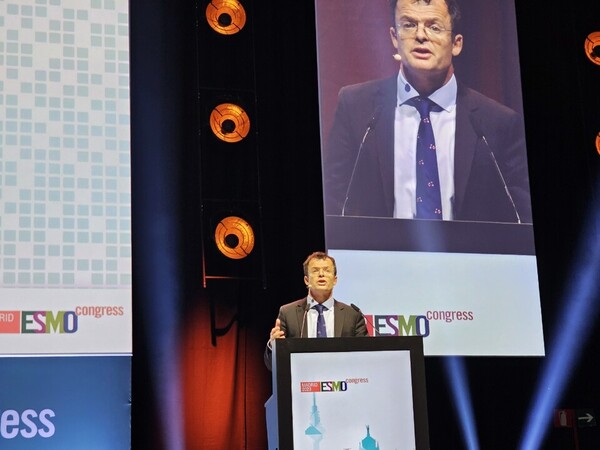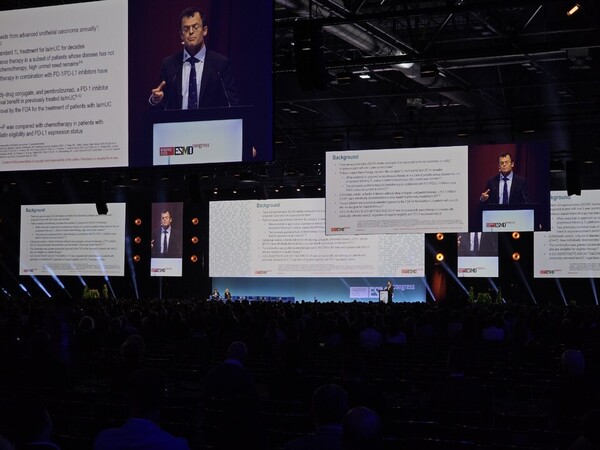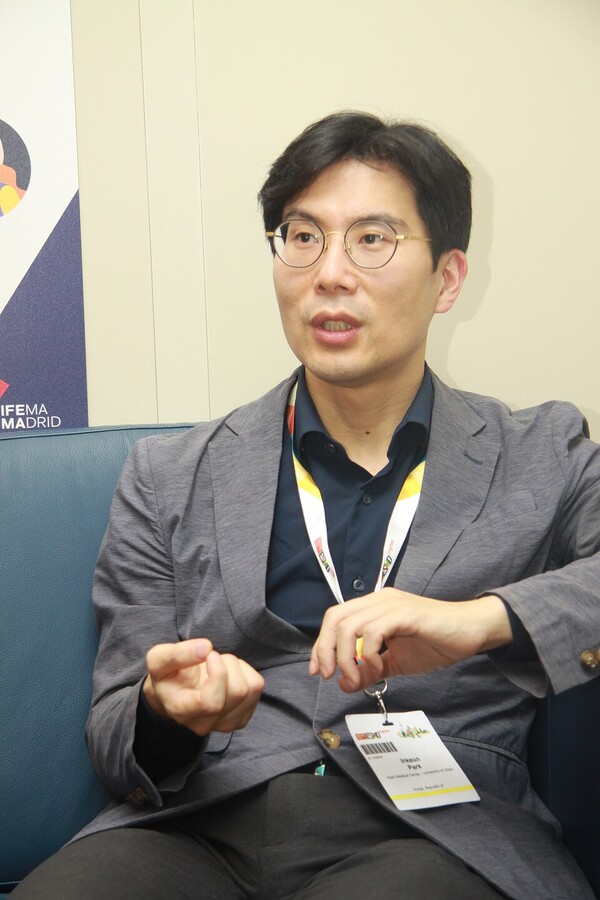
MADRID -- By Kim Chan-hyuk Korea Biomedical Review correspondent -- An enthusiastic standing ovation erupted in the Madrid Hall of the Ipema Convention Center, home to the European Society for Medical Oncology's Annual Meeting (ESMO 2023) in this Spanish capital city, on Wednesday.
That occurred when a screen showed the overall survival (OS) benefit of Keytruda (pembrolizumab) in combination with Padcev (enfortumab vedotin) in locally advanced metastatic urothelial carcinoma (la/mUC).
On that day, the combination of MSD's anti-PD-1 immuno-oncology drug Keytruda and Astellas' antibody-drug conjugate (ADC) Padcev achieved a 53 percent lower risk ratio than standard-of-care chemotherapy, marking the first time in more than 30 years that first-line treatment for urothelial cancer has been replaced.
It was particularly welcomed for its ability to extend treatment benefits to patients unable to receive the current standard treatment, cisplatin. In addition, Keytruda demonstrated that immuno-oncology can be a backbone treatment for urothelial cancer, a disease for which chemotherapy has been the standard of care (SOC)
The KEYNOTE-A39 (EV-302) trial, a collaboration between MSD and Astellas, is a phase 3 study confirming the first-line efficacy of Keytruda in combination with Padcev (P+EV) in patients with locally advanced metastatic urothelial cancer.
Regardless of PD-L1 expression, 886 patients with previously untreated locally advanced urothelial carcinoma were randomized 1:1 to receive Padcev (1.25 mg/kg, i.v.) on days 1 and 8, Keytruda (200 mg, i.v.) on day 1, or gemcitabine plus cisplatin or carboplatin every three weeks.
The primary endpoints were progression-free survival (PFS) and overall survival (OS) according to RECIST v1.1 as assessed by the Blind Independent Committee Reviewer (BICR). Secondary endpoints included overall response rate (ORR) and safety.

At data cutoff, median follow-up was 17.2 months, and mPFS was 12.5 months vs. 6.3 months with Keytruda plus Padcep vs. chemotherapy, respectively, with a significant prolongation of PFS with Keytruda plus Padcev, reducing the risk of disease progression or death by 55 percent (HR=0.45 [95 percent CI: 0.38-0.54] P<0.00001), according to Professor Thomas B. Powles of Barts Cancer Centre, University College London, who presented the results.
Notably, another primary endpoint, mOS, was significantly prolonged with Keytruda+Padcev compared to chemotherapy, at 31.5 months and 16.1 months, reducing the risk of death by 53 percent (HR=0.47 [95 percent CI: 0.38-0.58]; P<0.00001). The overall response rates (ORRs) were 67.7 percent and 44.4 percent for the Keytruda+Padcep combination and chemotherapy (P<0.00001).
Grade 3 or higher treatment-related adverse events (TRAEs) occurred in 55.9 percent of patients in the Keytruda+Padcev combination arm and 69.5 percent in the chemotherapy arm, with the most common adverse events being maculopapular rash (7.7 percent), hyperglycemia (5.0 percent), and neutropenia (4.8 percent) for Keytruda+Padcev combination and anemia (31.4 percent), neutropenia (30.0 percent), and thrombocytopenia (19.4 percent) for chemotherapy.
The most common (≥5 percent) grade 3 or higher TRAEs in the Keytruda+Padcev arm were skin reactions (15.5 percent), peripheral neuropathy (6.8 percent), and hyperglycemia (6.1 percent). The most common (≥5 percent) grade 3 or higher treatment-related serious adverse events included severe skin reactions (11.8 percent).
Dr. Fowles evaluated the Keytruda+Padcev combination as significantly improving outcomes for patients with previously untreated locally advanced metastatic urothelial cancer, nearly doubling median PFS and OS compared to chemotherapy.
Dr. Andrea B. Apolo, Chief of the Genitourinary Malignancies Branch at the National Cancer Institute (NCI), who served as a panelist for the day's Presidential Session, emphasized that the findings establish Keytruda plus Padcev as a new first-line treatment for locally advanced metastatic urothelial cancer.

While commenting on the data, Dr. Park In-geun, professor of the Medical Oncology Department at Asan Medical Center, said, "Not only has the first-line treatment changed in 30 years, but it has also doubled the survival time. This is rare. It has the advantage of high ORR and long DOR. The response is so good that it will not be easy to beat it for a while."
Professor went on to say, "There are about 40 to 50 percent of patients with urothelial carcinoma who cannot be prescribed cisplatin due to renal dysfunction. Cisplatin has ototoxicity, so it cannot be prescribed to patients concerned about hearing loss. Even more meaningful, it shows a good effect in so-called cisplatin-ineligible patients.”
However, Park pointed out that the problem is price, as was noted in the post-presentation discussion, and toxicity management, something that physicians will have to get used to in the future.
“We're seeing a lot of neurotoxicity, and I think in the future, we're going to see something like temporarily stopping Padcev in the middle of a (prescription cycle)," he added.
Dr. Park also commented on the Opdivo (nivolumab) results of BMS and Ono Pharmaceuticals plus gemcitabine plus cisplatin combination therapy trial (CheckMate 901) announced on the same day.
"For example, for those who cannot use Keytruda plus Padcev due to severe skin disease or cost, the Opdivo combination may be an option," he said. "But I don’t think the neurotoxicity is a reason to use the Opdivo combination."
He added that the issue of neurotoxicity would also arise with the Opdivo combination because of the cisplatin and the Opdivo combination is very limited because it is targeted only at patients who can use cisplatin.
“However, it is clear that cisplatin is still an effective agent," Park said.
Regarding Bavencio (avelumab) of Merck, which is approved in Korea as a first-line monotherapy for locally advanced or metastatic urothelial cell carcinoma that has not progressed after receiving platinum chemotherapy, Park said, "You can't think you will use P+EV from the beginning because you don't know if the patient will respond or not, and clinicians will choose the drug with the best response."
In addition, Dr. Park said he believed that the change in first-line regimens would affect the interpretation of results from many trials with the standard gemcitabine plus cisplatin as the control arm.
"We have a neoadjuvant (preoperative adjuvant) trial with Keytruda plus Padcev. The experimental arm is Keytruda+Padcev, and the control arm is gemcitabine+cisplatin. If the Keytruda+Padcev combination is successful in the neoadjuvant setting, the adjuvant Opdivo could be like the fifth wheel," he said.
However, according to Professor Park, even with these improved therapeutic benefits, it will be some time before the combination of Keytruda+Padcep is widely prescribed in Korea.
"Cost is the biggest issue. Padcev will be available in Korea, but it is only approved for the third time. Moreover, using the combination of Keytruda and Padcev off-label isn't easy. It will cost more than 10 million won ($7,500) a month," he said. “I don't think it will become a standard treatment in Korea until the mid- to late-2024."
Related articles
- [ESMO 2023] Keytruda cements its position as 1st-line treatment for HER2+ gastric cancer
- [ESMO 2023] Global competition for anticancer therapies opens yearly event in Europe
- [ESMO 2023] Yuhan's NSCLC drug Leclaza shows potential as 1st Korean blockbuster drug
- [CPHI 2023] Prestige Biopharma embraces open innovation for new antibody drugs
- [ESMO 2023] GI Innovation lays ground for Keytruda’s clinical trials
- Korean biotech firms spearhead biosimilar race for MSD's Keytruda as patent expiry looms
- MSD's Keytruda wins 2 new approvals for 1st-line gastric cancer, early-stage lung cancer

